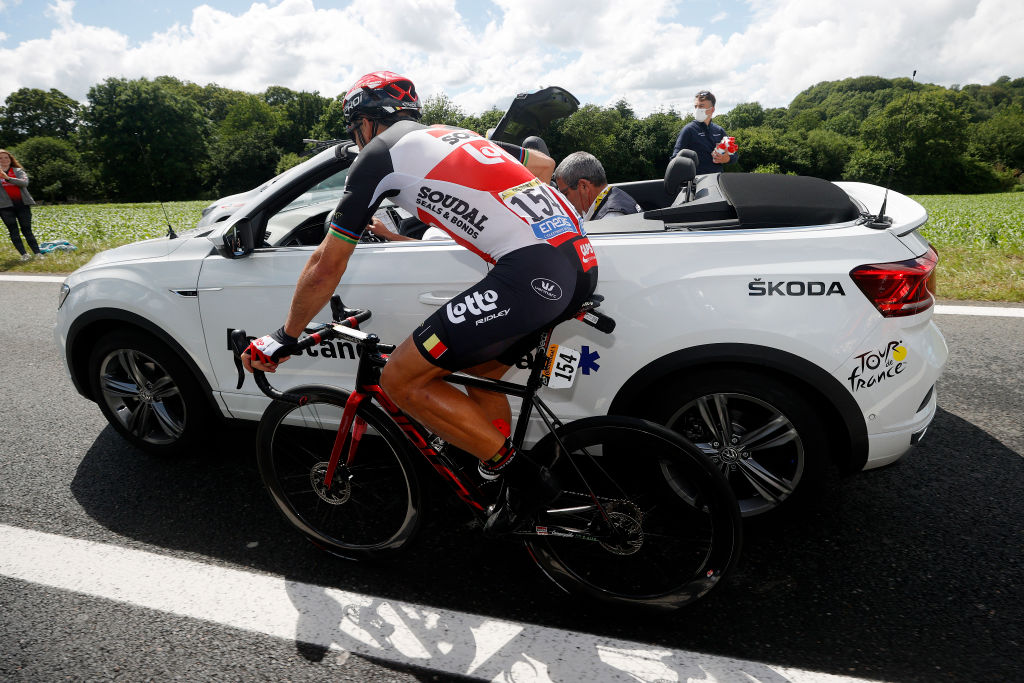Tour de France stage 3 route 'a big mistake' says Gilbert
Belgian reveals neutralisation request was granted by ASO but rejected by UCI

Before any protests at the start of stage 4 of the Tour de France, and before any official position from the two rider associations - the CPA and Riders' Union - Philippe Gilbert gave his opinion on the crashes that shook up stage 3 and suggested how they could have been avoided.
Primož Roglič (Jumbo-Visma) was a notable victim of the first crash with 9km to go, suffering multiple wounds and losing 1:21 to some of his overall rivals, while a large group of riders crashed at the four-kilometre mark, with Jack Haig (Bahrain Victorious) out of the race as a result.
In the final metres of the stage, as the road kinked right, Gilbert's Lotto Soudal teammate Caleb Ewan touched wheels and went down with Peter Sagan (Bora-Hansgrohe) at high speed.
Gilbert has often given up his own time to help to represent his fellow riders and improve safety at races.
He confirmed reports that the rider representatives and the CPA asked for the stage timings to be taken with five kilometers to go, in advance of the most dangerous corners and narrow roads. Tour de France organiser ASO apparently agreed but the UCI race commissaires refused to approve the idea because the current UCI rules do not permit it.
"I think it was a bad day for cycling. We don’t like to see crashes, it’s not good for the sport. Lotto Soudal was hit badly and so we’re all sad," Gilbert said in a personal video posted on YouTube.
"Unfortunately we lost our sprinter Caleb Ewan, who fractured his collarbone in a crash. We wish him a rapid recovery and hope he can be racing again at the Vuelta.
Get The Leadout Newsletter
The latest race content, interviews, features, reviews and expert buying guides, direct to your inbox!
"I’ve got a lot to say about the stage," Gilbert continued, offering a balanced and informed view of events and possible solutions. "Even before yesterday’s stage there was a lot of talk between the different rider representatives in each team and the CPA representative at the Tour de France, Pascal Chanteur.
"The riders proposed to take the times at 5km to go. We analysed the race route and we thought it was extremely dangerous. To avoid any nervousness in the peloton, we proposed to take the times with 5km to go to avoid the risk on the sinuous final section on roads that were far from perfect. ASO agreed but the UCI commissioners didn’t accept our request. That was a pity.
"We can’t only blame the route - the riders are also responsible for the way they race - but if this decision had been made it would have calmed everyone down.
"Everything that happened is very sad. I saw some of the crashes. The first two were caused by rider error, they crashed due to the nervousness of the racing. I read that Roglič crashed alone after touching Colbrelli’s wheel and so that’s not about the race route.
"I didn’t see the second crash but there was a turn with 4km, on a slight descent between walls. I imagine the riders took some risks because the position in the peloton you had there was almost certainly the position you’d have at the finish."
Gilbert understands the process of designing a race route and the final kilometres of each stage in the Tour de France. He suggested the rules and guidelines for route design, the so-called ‘cahier des charges’ had not been fully followed.
"There was a big mistake accepting this route," Gilbert said, also calling out other teams for not working together for a common good and wider safety in the peloton.
"What surprises me is that a number of teams reconned the route and didn’t say anything to ASO. If teams had pointed out the dangers then ASO could have changed the final kilometres. Communication is the key to everything."

Stephen is one of the most experienced member of the Cyclingnews team, having reported on professional cycling since 1994. He has been Head of News at Cyclingnews since 2022, before which he held the position of European editor since 2012 and previously worked for Reuters, Shift Active Media, and CyclingWeekly, among other publications.